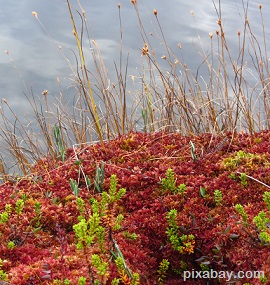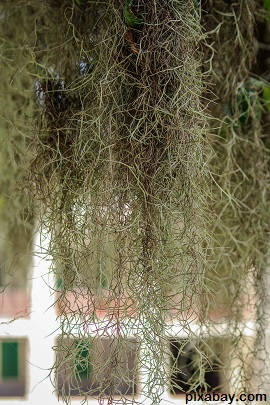What do you know about moss? It’s green and grows on trees, rocks and the ground, right? Sometimes it grows on the sides of a building, giving it that picture-pretty appearance. But is it good for anything? Well of course it is, especially in survival situations. If SHTF, moss can come in handy in several different ways. There are over 12,000 varieties and they all have uses.
Does Moss Really Grow on the North Side of Trees?
If you’ve ever been in the Scouts or read old country lore, you’ve most likely heard that if you’re lost, look for moss because it grows on the north side of trees. Sorry to dispel the myth or correct your Scout leader, but this isn’t the truth, at least in most cases.
If you’ve ever actually tried to determine direction using this method, you probably ended up scratching your head in confusion because there was moss all the way around the tree. This is because moss grows best where it’s moist and (preferably) shady most of the day. There IS one way that may help you find direction using moss, though.
If you manage to find a vertical surface that’s off the ground such as a big rock face that is covered in moss, that side is likely facing north in the northern latitudes because the surface isn’t directly in the sun after noon, the most drying part of the day. Remember – moss likes moisture.
Sphagnum Moss Is a Source of Drinking Water

However, if you’re in a survival situation, the odds of dying of dehydration most definitely outweigh the odds of finding halophiles in the moss. As a matter of fact, many survivalists regularly use moss as a water source and I haven’t heard of any that have ever had an issue.
Moss Is Great for Dressing a Wound
Many types of moss, including sphagnum moss, are great for dressing a wound. It acts as a natural iodine and is purportedly sterile because of this quality. After cleaning the wound, apply the moss as a bandage. Change the moss out each time you clean the wound.
This type of moss is also good for soothing and healing rashes. Just apply is as a bandage and change as it dries out. Relief will come quickly.
Dried Moss Is Extremely Flammable
If you can find dead moss or have the time to pick some and let it dry, it’s extremely flammable and is great for starting your fire. Since it’s lightweight, you may even want to add some of it to your homemade fire starters or just carry some raw.
Moss Is Waterproof
Moss is damp, isn’t it? Well yes it is but it likes to hold on to its water. You can use a nice layer of moss to cover your shelter and it will keep you dry. One of the best things about this is that, since moss has an interconnected, shallow root system, you can cut it in large chunks that make it easy to transport and cover your shelter quickly.
Within 24 hours, these root systems will grow together and you have an instant, waterproof roof. As a matter of fact, there are many stories of wilderness people who actually use moss to roof their houses.
Moss Is a Great Insulator
Because it’s so dense and has such a tight root system, moss makes an excellent insulator. If you use it to insulate your house or shelter, it will keep it either warm or cold, whichever you need at the time. It will hold body heat in, and it will keep heat out. A bonus benefit to using moss as part of your structure is that if you really need to, you can use it to capture clean drinking water!
Moss Camouflages You and Your Shelter
This probably should have been a bit closer to the top of the list of survival uses for moss, but here it is. If you’re on the run and trying to steer clear of invading forces or even roving plunderers, moss is a great way to camouflage your shelter.
Even if they pass by it and see the structure, if it’s an old building such as a shed that looks rickety and as if nobody’s been in it forever, they’ll be more likely to pass it by than if the place looks lived in or used. If you have a structure like this, try to place your entrance at the rear where it won’t be visible and don’t wear an obvious path to it.
Some Moss Is Edible
Food is heavy and you can’t carry much of it with you so if you can find it along the way, that’s awesome. There are several different types of edible moss, including:
- Reindeer moss is a light-colored lichen that only grows to be a few centimeters tall. There are no flowers but it does have bright red reproductive parts that look a bit like flowers from a distance. It’s found in most of the US in open, dry areas.
- Oak moss is found in the mountainous regions of the US and grows, as the name suggests, on oak trees. It looks almost like a piece of coral growing from the side of the tree, at least to me, and has a pale, greenish-gray “leaves” that are pointy. They grow to be about 3-8 centimeters long. They grow together to form large clumps.
Spanish moss is that beautiful, draping moss that hangs from trees, mostly oak trees, throughout the US and especially in the eastern southern states. It’s light colored, nearly white in many cases and grows in what appears to be strings.
Technically, Spanish moss isn’t moss at all but a member of the bromeliad family.
Still, we’re including it because you can eat it and it’s also believed to have some medicinal properties, including helping lactating mothers produce milk and helping relieve the symptoms of rheumatism, diabetes and infantile epilepsy. It’s also been used as an estrogen substitute and Spanish moss has antibacterial properties.
You Can Use Sphagnum Moss to Filter Water
Because of the high acidity and the antibacterial properties of sphagnum moss, it can be included in your filtration system to help filter your water.
The survival uses for moss are many and varied. We’ve barely scraped the surface in this article, especially when addressing the medical and edible benefits of moss, but at least now you get the gist of it. If you have any other survival uses of moss, please share them with us in the comments section below!
This article has been written by Theresa Crouse for Survivopedia.



 Spanish moss is that beautiful, draping moss that hangs from trees, mostly oak trees, throughout the US and especially in the eastern southern states. It’s light colored, nearly white in many cases and grows in what appears to be strings.
Spanish moss is that beautiful, draping moss that hangs from trees, mostly oak trees, throughout the US and especially in the eastern southern states. It’s light colored, nearly white in many cases and grows in what appears to be strings.






B. Woodruff | July 27, 2015
|
Hi, since you included Reindeer Moss in your article and it’s really a lichen, perhaps you should also include Usnea barbata, Beard Moss or Old Man’s Beard. Possibly the most ubiquitous edible/medicinal lichen around. Spanish Moss, Tillandsia usneoides get’s it’s name from Usnea because of their similar appearance. Usnea, a lichen, is a medicine chest all by itself, being Anti-bacterial, Anti-biotic, Anti-fungal, Anti-viral, Astringent, Diuretic, Parasiticide, Immune system enhancer, General tonic and Tuberculostatic.
Great for strep throat, pneumonia and urinary infections. We use it for field dressing cuts or puncture wounds. Very good to know in a wilderness survival situation.
Ella | December 13, 2016
|
I was always told to stay away from Spanish moss, because of the bugs that it infested with. So do I clean it first?
Carriesharing | February 12, 2021
|
The bugs( chiggers) infest Spanish moss once it has dropped from trees and is on the ground. I haven’t heard of Spanish moss in trees being infested with chiggers. So for safety only use Spanish moss directly from trees.
Nicholas N | May 10, 2018
|
On my wilderness survival trip it was dead and dried and we called it witches hair, used it as toilet paper.
Pingback:Moss's Survival Uses Are Pretty Crazy | Survival Frog Blog | November 5, 2015
|
KayEhm | April 10, 2016
|
Green moss is extremely useful for efficient survival of both flora and fauna (humans inclusive). They’re ability to retain moisture keeps everything cool and nourished for longer and less. Oregon has the best climate for producing it – couple that with the fact that Oregonians enjoy putting the properties of nature to good use, purchasing green moss from Oregon is a wise decision for your garden. Oregon Evergreen & Willamette Evergreen sell the highest quality Oregon Green Moss (a.k.a. Sphagnum Moss) packs in 25 lb bales, at 25 bales per pallet; 10lb, 5lb, and 2lb bales; as well as in 1lb polybags! Check that and more out at http://www.willametteevergreen.com/wholesale-oregon-green-moss-sphagnum
Trevor | July 24, 2016
|
Have You Been Smoking It Too , I May Ask ?
Nike | June 9, 2016
|
Is mood miss edible? Could input it in my water and drink through it? Or serve my good on top of it?
Kay | November 14, 2016
|
Sphagnum Moss is an easy and efficient way to ensure you and your family has plentiful drinking water. You can and should buy wholesale green moss from http://www.willametteevergreen.com so you can be prepared at an efficient up-front cost.
kg | January 10, 2017
|
Moss does not have roots.
Teresa | May 25, 2017
|
If there is sphagnum moss growing in the stream, is the water safe to drink?
wanda radcliff | August 6, 2017
|
You can not hire people to do evil when money will be of no worth. It will best to learn the old ways. Those who do not know will not it will not survive..
Barbara | October 2, 2017
|
It would be nice if you could include photographs so we can make certain not to eat poisonous moss. Also if you insulate your house with flammable moss won’t it burn easily?
Cstal | October 17, 2017
|
All good info, however don’t let one source be your defining point for what you now deem edible. Do more research. I find books to be better that Web. Less misleading info!
Ezre B | December 9, 2018
|
Thanks for the care and concern.